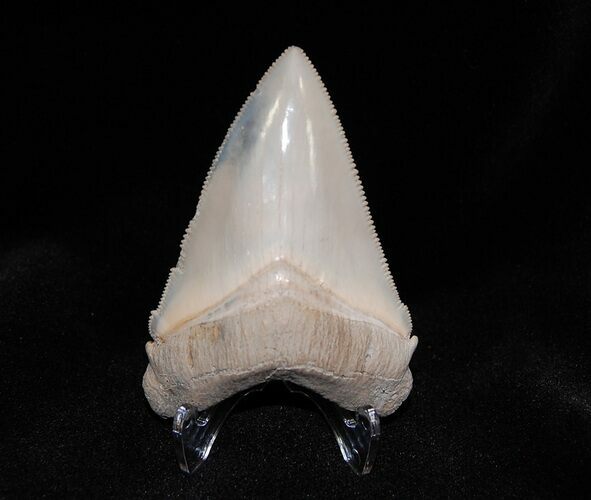This Specimen has been sold.
Absolutely Killer Carcharocles chubutensis
This tooth is just flat out stunning. It's a 2.99 inch long Carcharocles chubutensis from the Lee Creek Mine in Aurora, NC. This tooth has amazing serrations, a very sharp tip and a beautiful glossy grey enamel. The Lee Creek Mine is no longer accessible to public collecting so these teeth are harder to come by.
Carcharocles chubutensis is a terrifying prehistoric megatooth shark that lived roughly 28-5 million years ago. This formidable beast, estimated at 35-40 feet of jaw-snapping horror, shares infamy with the Megalodon. Its coexistence with Megalodon during the Miocene (23 mya) and Pliocene (5.3-1.7 mya) epochs, as well as similarities in their dentition, has brought about taxonomy debate worthy of this giant apex predator.
Like the Megalodon only smaller, C. chubutensis used serrated teeth to grab and rip apart fish, sea turtles, whales, and sirenids (sea cows). Habitat preferences may have changed through time, or C. chubutensis may have had enough behavioral flexibility to occupy different habitats as the ecology changed.
A prolific survivor, C. chubutensis stalked and shredded across the warmer reaches of the globe during the Oligocene, Miocene, and Pliocene. These epochs are marked by progressively developing icecaps and changes in ocean currents while tectonics aligned the continents to their modern positions.
The cartilaginous nature of the megatooth shark's skeleton limits fossil evidence to tooth morphology and some vertebral centra. Based on dentition, C. chubutensis is believed by many to be closely related to Megalodon and may have been a direct ancestor or a co-existing morpho-species. Its serrated transitional teeth suggest that of an ancient mackerel shark.
Otodus evolved from the Paleocene (65 mya) into the Carcharocles lineage. C. chubutensis teeth have two small cusps at the base of the tooth and are comparatively slender with a curved crown and feebly serrated lateral heels. Megalodon teeth generally have a straight edge from tip to base. However, commonality of teeth during growth further muddies the taxonomic waters.
Fossils of this species have been found in North America, South America, and Europe.
Like the Megalodon only smaller, C. chubutensis used serrated teeth to grab and rip apart fish, sea turtles, whales, and sirenids (sea cows). Habitat preferences may have changed through time, or C. chubutensis may have had enough behavioral flexibility to occupy different habitats as the ecology changed.
A prolific survivor, C. chubutensis stalked and shredded across the warmer reaches of the globe during the Oligocene, Miocene, and Pliocene. These epochs are marked by progressively developing icecaps and changes in ocean currents while tectonics aligned the continents to their modern positions.
The cartilaginous nature of the megatooth shark's skeleton limits fossil evidence to tooth morphology and some vertebral centra. Based on dentition, C. chubutensis is believed by many to be closely related to Megalodon and may have been a direct ancestor or a co-existing morpho-species. Its serrated transitional teeth suggest that of an ancient mackerel shark.
Otodus evolved from the Paleocene (65 mya) into the Carcharocles lineage. C. chubutensis teeth have two small cusps at the base of the tooth and are comparatively slender with a curved crown and feebly serrated lateral heels. Megalodon teeth generally have a straight edge from tip to base. However, commonality of teeth during growth further muddies the taxonomic waters.
Fossils of this species have been found in North America, South America, and Europe.
SPECIES
Carcharocles chubutensis
AGE
LOCATION
Lee Creek Mine, Aurora, NC
FORMATION
Pungo Formation
SIZE
2.99"
CATEGORY
SUB CATEGORY
ITEM
#109
We guarantee the authenticity of all of our specimens.
 Reviews
Reviews













